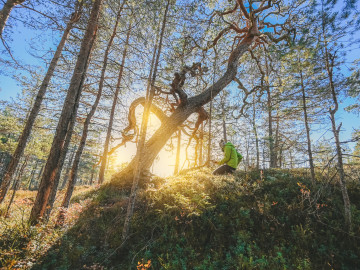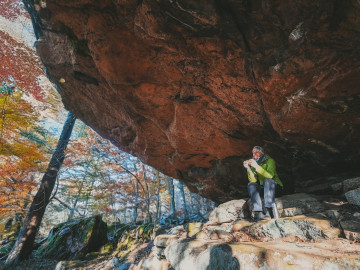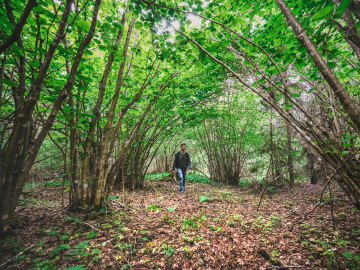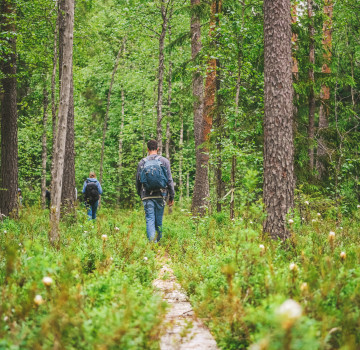
About the trail
The nature trail is located on the grounds of Västankvarn Farm and stretches from Söderlandsvägen up towards Slätberget. The trail passes through varied terrain with different types of nature, including an exciting cliff overhang, a mire, a mountain area with dry furrows, an old forest and hazel grove, and a wetland.
You can reach the start of the nature trail from road 51 by turning onto Söderlandsvägen. The nature trail starts from the car park at the Grav 1918 memorial, Söderlandsvägen 111, where there is a map of the area. The longer route is 3.2 km long and the shorter one is 1.75 km. There are information signs along the trail. Parts of the trail go through mountainous areas that can be challenging. There is no winter maintenance in the area, but the trail is open all year round. It is worth reserving at least 2 hours to walk the longer route.
You can download the map here


Kalbergshyllorna
Kalbergshyllorna is an exciting rock formation with a large overhang. The nature trail passes by the rock outcrop, but it can also be reached from the nearby gravel road to the west. The weathering of limestone and minerals from the mountain makes the soil below fertile, and many types of mosses, lichens and ferns grow here. The forest between the cliff and the car park is used for commercial forestry and was cut in 2024. After the cutting, a natural succession of plants can be seen. It is forbidden to light fires or climb on the cliff.

Old-growth forest
The nature trail goes through parts of a forest that hasn't been cut in over 100 years. This forest will be protected. Old forests act as a stabilising force: they purify air and water, store carbon dioxide and protect against erosion and flooding. Dead trees are left in place, which benefits fungi, insects and birds, while enriching the soil through natural nutrient recycling.
The forest acts as a carbon sink, where young trees actively absorb carbon while older trees act as carbon storage. However, the carbon is released back into the atmosphere if the trees are cut down and burned or used for short-lived products. Beneath the ground surface is a complex network of microorganisms and fungi, where the mycelium provides the trees with nutrients in exchange for sugar. When trees are cut, this network is damaged, and it can take up to 30 years for it to recover. Preserving old forests and allowing dead wood to decay naturally promotes biodiversity and climate stability.

The hazel grove
Near the wetland is a hazel grove, which can also be accessed directly from the gravel road. Common hazel grow naturally only in southern Finland, on nutrient-rich, calcareous soils with deciduous or mixed forests. Hazel groves are a diverse biotope where many species thrive, especially fungi and insects, which thrive in the rotten trunks. Since many groves were previously converted into farmland, those that remain today are small. The groves are now protected under the Nature Conservation Act.

The mire
The small mire has formed in a depression where water collects and the soil has become oxygen-depleted. Bog moss, Labrador tea, cottongrass, blueberries and cloudberries grow here. Mires are important for binding carbon, purifying water and preventing flooding. A large proportion of the bird species that breed in Finland are dependent on mires at some stage of their lives. Flying squirrels have been spotted in this area.

